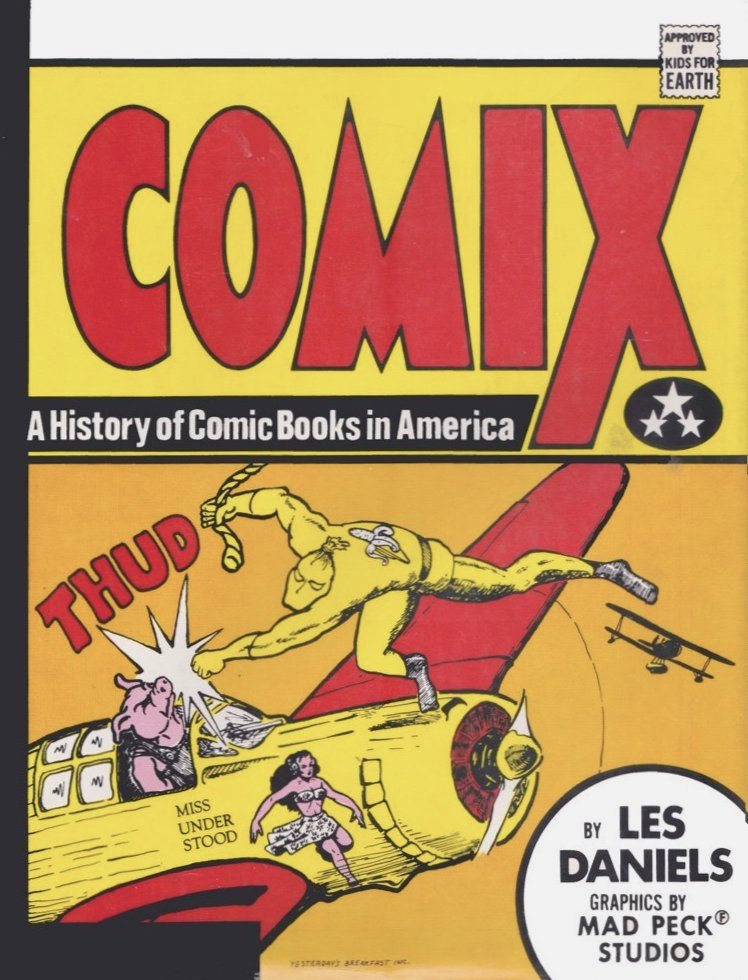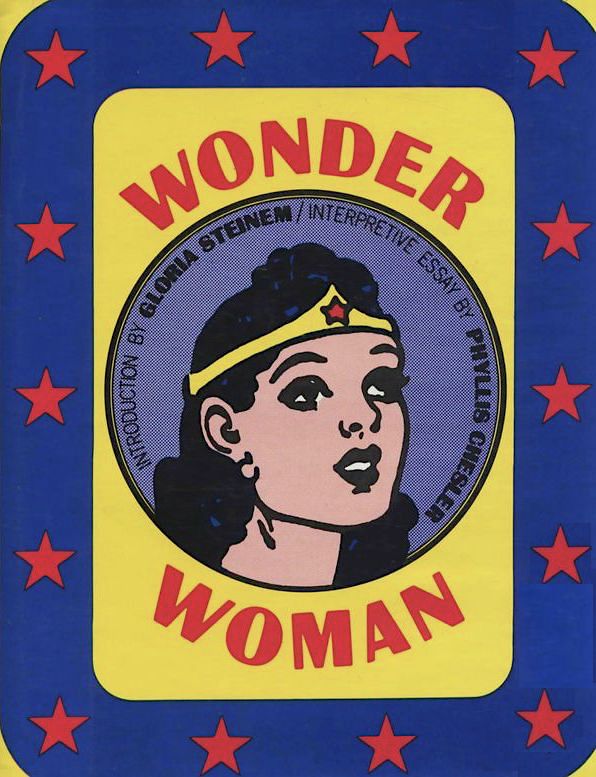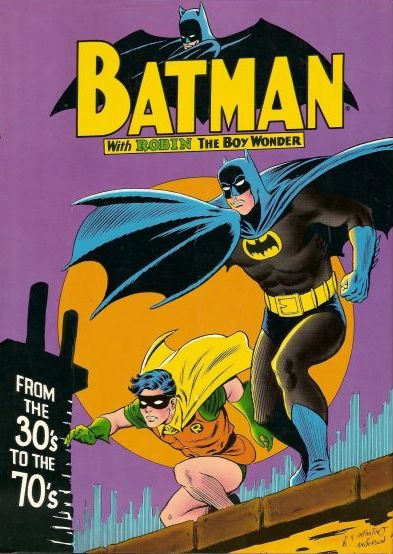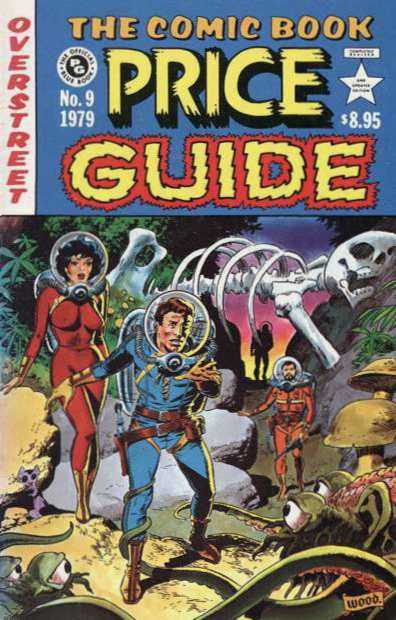I’m still not writing enough about my lifelong passion for comics.
Convenience stores, newsagents, and 5-&-10s in South Jersey fed my early habit,
as I shared last year. Only so much history could be gleaned from comic-book reprints and editorial pages, however. Luckily, a bevy of books on comics awaited at the Cape May County Library, where surveys of my favorite four-color fantasies and their forebears could be found in (mostly) cold, hard black and white.

The one I checked out most often was a 1973 tome aptly titled The Comic-Book Book, edited by Dick Lupoff and Don Thompson. I read it with such fervor and frequency
that my dad finally just bought it for me — the actual library copy. Whether he felt bad that its sturdy hardcover spine was breaking or the staff figured that mine was the only name ever on the circulation card so we might as well skip the formalities, I don’t know. But it remains a prized possession and is even more of a collector’s item now than it would otherwise be for reasons I’ll reveal later. Not too long into my quest for similar material, I got my hands on a paperback of 1970’s All in Color for a Dime, the collection of essays from Lupoff’s fanzine Xero to which CBB was a sequel; I sucked in its tales of the primordial days of superheroes and the industry that spawned them until the book was left a brittle, coverless husk.


Also in the small section of the stacks devoted to my growing passion, devoured over and over again by me, were Les Daniels’ 1971 Comix: A History of Comic Books in America, Jules Feiffer’s 1965 The Great Comic-Book Heroes, and one or more of the Crown family books dedicated to DC characters. Daniels’ effort consisted of chapters on various facets of comic-book lore, not unlike The Comic-Book Book, while Feiffer’s was part history and part memoir, covering the author’s boyhood adoration of the medium’s costumed crime-fighters. Feiffer’s prose was too adult-oriented for me in the single digits of age — I was unaware that he’d worked alongside the legendary Will Eisner on The Spirit as a young man, nor that he’d become a celebrated author and cartoonist in his own right — but the back half of the book was made up of comic-book reprints in color, many of which I’d never seen before, featuring Quality’s Plastic Man, Timely/
Marvel’s Human Torch and Captain America, and others. Fireside’s Origins of Marvel Comics anthologies, then beginning to show up in bookshops, didn’t reach that vintage.


Superman and Batman’s stories in The Great Comic-Book Heroes weren’t quite as exciting as those of less widely known characters because their archives were regularly mined in DC’s tabloid-sized comics and plumbed for posterity in the aforementioned Crown/Harmony/Bonanza books. I’m sure that the library had at least the first of those books, 1971’s Superman from the Thirties to the Seventies, but I eventually received it as a gift and soon got hold of further volumes covering Batman, Wonder Woman, and the Captain Marvel family (originally published by Fawcett, by then licensed and later purchased outright by DC — which, deep breath now, had to market the characters under the family’s magic word, Shazam!, since the trademark on the name Captain Marvel lapsed a decade before DC’s revival of the characters and was picked up, appropriately if frustratingly for fans of the original, by rival comic-book publisher Marvel). Unlike its brethren, edited with notes by DC historian E. Nelson Bridwell and covering the title characters from their origins to contemporary adventures, the 1972 Wonder Woman book had no subtitle, limited its reprints to the Golden Age, and featured sociopolitical essays from Gloria Steinem and psychologist Phyllis Chesler.


While the bygone tales of DC’s big guns were fascinating and just plain fun, The
Comic-Book Book held a different thrill. I learned of series, creators, and characters much older and often farther afield than anything I’d read; some were seriously obscure, others known to and beloved by fans many years my senior — in either case, nothing I likely had a chance of seeing outside of small, grayscaled reproductions in
my conglomeration of loaned and owned comic-book texts, which came to include the 1979 edition of The Overstreet Comic-Book Price Guide. The breadth of genres popular in previous eras, from horror to science fiction to romance, was of academic interest even as I paid little attention to stuff beyond superheroes on the spinner racks. But there were certainly superheroes here too, many of whom I drew based purely on their descriptions in prose, as if recreating a baseball game from box scores.

No entry for The Comic-Book Book turns up in the library’s online catalog for me, so
the copy my dad bought may never have been replaced. I should rectify that, since new trade-paperback editions of CBB and All in Color for a Dime were released in 1997 and 1998 by Krause, the publisher of Comics Buyer’s Guide, and they deserve to be there. Now a slick monthly magazine, CBG remained a weekly newspaper for decades after Krause acquired it from originator Alan Light — co-edited by Don Thompson,
who assembled Dime and CBB with Dick Lupoff, and his wife Maggie Thompson, who contributed an article on The Spirit to CBB and is the senior editor of Buyer’s Guide today. I sold my first article to CBG in college and saw Don at a number of Roger Price’s Mid-Ohio Cons around that time, not star-struck exactly but amazed to be chatting
with one of the men responsible for such a vital piece of my childhood.
During my years on the comic-book scene I was fortunate enough to interview, work with, befriend, or simply pay my respects to many women and men who wrote and
drew treasured tales in my collection or were seminal figures in the medium’s history, from Will Eisner to Julius Schwartz to Ramona Fradon to Stan Goldberg to John Byrne, naming just a few folks from indelible moments that flash to mind. Although I’ve never cared about autographs for their own sake, I cherish a handful of personalized items from people with whom I had meaningful exchanges, and it finally dawned on me to bring my original copy of The Comic-Book Book to a convention for Maggie to sign after Don’s untimely passing. I can’t dig out the book right now to share what she wrote, but it’s of interest to anyone who’s read her article and, indeed, I believe she adds a similar note to every copy of CBB she’s given. How I went from poring over the Thompsons’ handiwork as a kid to writing for them, even geeking out during a ride with Don in the Krause van from our hotel to the convention hall one fine Ohio morning, I can’t exactly say; I can tell you that it had a lot to do with seizing unexpected opportunities to follow my dreams, often bereft of a clear plan. I hope that yours have led you to similarly welcome surprises.
All cover art, logos, and characters property of their respective trademark and copyright
holders, depicted for reference, some retouched and recolored for online display.
Related: K-a Blam • 41 Favorites: #6 • Myth and Fingerprints

Great post, Blam. I love your TV reviews and fun little posts, but I'd be very happy to see more like this.
ReplyDeleteWhen I first got into comics, I had a similar experience to you: the half dozen or so books on comic books (if I remember by Dewey Decimal System correctly, I believe the books on comic books were in the 720s) were an invaluable and oft read resource, and did much to expand my growing knowledge and love of comics.
ReplyDelete